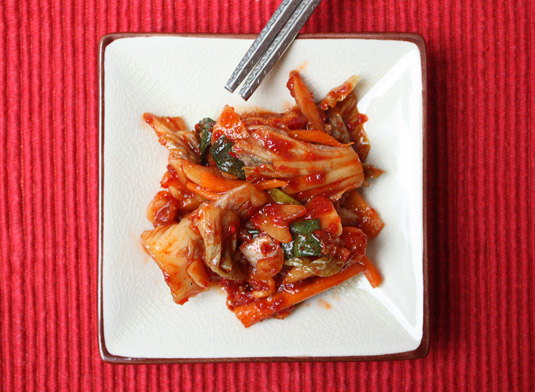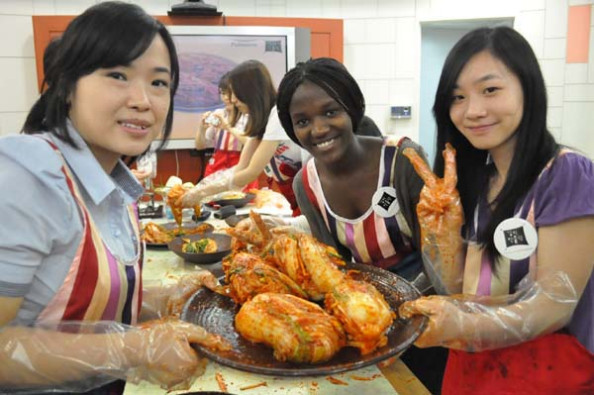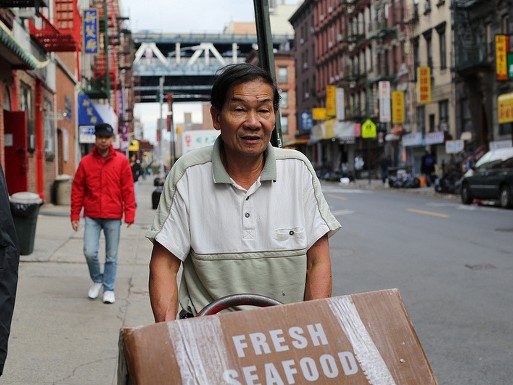Carolyn Sun explores the journey of how kimchi has found its place in America at the tables of Koreans and non-Koreans alike.

February 6, 2013
Back when I was a kid, I could not have predicted the way kimchi would grab a foothold in today’s mainstream food scene. I was one of three Asian families in my pastoral upstate New York hometown which ensured not many—except those in my immediate family—even knew about kimchi, much less ate it. As a result, my relationship with kimchi embodied both love and hate. While I could eat jars of it just on its own, I hated that eating it set me apart from those around me. Not only did kimchi look like a bizarre science project enshrined inside enormous glass jars, but I could not deny its smell. My childhood best friend, a blonde, green-eyed girl of Russian descent, once described it as smelling like “hot garbage.” She wasn’t far off the mark.
Today, kimchi is popping up in unexpected places like Dean & DeLuca’s flagship Soho store and Whole Foods in Union Square which both sell Lauryn Chun’s Mother-in-Law’s Kimchi. Chun’s cookbook The Kimchi Cookbook came out in November of 2012. illustrates inventive ways to use kimchi in recipes such as risotto and even in a grapefruit margaritas. Chun will be touring the West Coast to promote her cookbook and perform cooking demonstrations.
Kimchi is also featured on PBS’s television show, The Kimchi Chronicles, hosted by Marja Vongerichten, the wife of three-star Michelin chef Jean-Georges Vongerichten. It appears on the menu at The Green Table, a farm-to-table organic eatery in Chelsea Market where they serve a dry-aged beef burger on a brioche bun with kimchi on top. So, is kimchi the new ketchup?
More like sauerkraut, according to the man who put the kimchi on the burger, Chef Brent Sims (who now works at Dizzy’s in Columbus Square). He says he doesn’t know a lot about Korean food, and cites that he used kimchi on his burger, because he “loves fermented foods.” He also thought kimchi would be an inventive replacement for the standard tomato and lettuce.
“Nobody says ew,” Chefs Sims says.
The average Korean person living in Korea consumes 40 lbs. of kimchi a year. Kimchi has earned its own museum in Seoul, Korea, the Pulmuone Kimchi Museum where a visitor can view exhibits about the history of kimchi starting in Three Kingdoms Era (4 A.D. to 7 A.D.) to the present and peer upon 80 various plastic models of kimchi—although it’s said there are over 100 different kinds.
In Korea, kimchi even appears on the pizza and in chocolate bars. It’s extremely high in fiber and Vitamins A, B and C. Plus, it’s low in calories and contains a natural lactobacilius found in yogurt which aids digestion and promotes good bacteria in the small intestine. Not yet labeled a superfood, like salmon or kale, it’s at least a verygoodforyoufood. It’s also addictive, says Mr. Kim, owner of New York Kimchi Company located in Astoria, Queens and Kum Gang Sang which has two locations, one in Astoria and one on 32nd St. in Manhattan.
“I don’t know one Korean who can live without it,” he says.
According to Kim, even Mayor Bloomberg has a penchant for kimchi—Bloomberg once treated two hundred of his employees to dinner at the restaurant’s Flushing location.
In spite of kimchi’s undeniable presence in the culinary scene, many Americans still don’t know what kimchi is outside of the ethnic food cities of New York and Los Angeles which each carry the largest populations of Koreans in the United States at 96,741 and 216,501 respectively according to figures gathered by the 2010 U.S. Census Bureau Data.
The average Korean person living in Korea consumes 40 lbs. of kimchi a year.
Like many pickled, ethnic foods, kimchi was born several thousand years ago as a way to preserve vegetables during Korea’s long, hard winters. Korea being a largely agrarian society with its diet staples, rice and vegetable side dishes known today as ban chan—or all those little side dishes you get at Korean restaurants. Pickling and fermenting its vegetables in large crockery pots was the method of preservation pre-refrigeration. It wasn’t until the red chili flake was introduced to Korea from Europe in the 1600s that kimchi reached its full complexity and exists as what it’s thought of today—a combination of root vegetable, red pepper flakes, garlic, vinegar, scallions and ginger and salted shrimp or anchovies, depending on the region.
Although cabbage is synonymous with kimchi, all kinds of vegetables are used for kimchi pickling—radish, carrots, cucumbers, scallions and leafy greens. Seasonal vegetables are popular in the food scene and at Danji, a Korean restaurant in Hell’s Kitchen. Chef Hooni Kim, a 39 year-old Korea-born chef with expressive eyebrows and a shaved head, says his mother-in-law makes the kimchi served at the restaurant according to the Korean tradition of what vegetables are in season. His restaurant is small with pale yellow walls and sleek Scandanavian wood tables. It’s not the décor you’d find along 32nd St. in Koreatown, and Chef Kim is extremely aware of this.
“Most Korean restaurants are about volume, not service and the experience. Here, I wanted to offer attentive service and small portions.”
He’s part of new-breed of chefs re-interpreting the Korean food experience. Chef Kim pairs kobe beef sliders with kimchi-infused mayonnaise and a Korean-paella dish with kimchi, pancetta and chorizo on his menu.
“I don’t think I have to serve exactly what I see in Korean restaurants to maintain Korean flavors,” says Chef Kim.
Kim recently opened a second restaurant, Hanjan, in the Flatiron District which has been compared to a “Korean Spotted Pig”—meaning a tavern serving earthy comfort foods. When asked about the kimchi he serves, Chef Kim goes into the walk-in refrigerator where he keeps his mother-in-law’s homemade kimchi along with store-bought jars.
“At first, we used only fresh kimchi my mother-in-law makes,” he says, “but then we got written up in New York Magazine, and our business quadrupled. So, now we use store-bought kimchi for our cooked dishes.”
Asked if he’ll use kimchi in any unexpected ways–like in a gelato–he rolls his eyes.
“I don’t think fermented fish flavor goes with ice cream.”
But, does kimchi go with cheese? Kogi BBQ, the Korean taco truck based in Los Angeles, serves a kimchi quesadilla with kimchi and Monterey Jack cheese between two tortillas. Kogi’s founder, Roy Choi, a Harvard graduate, began the business in 2009 with two friends, and his business has exploded since with writes up in L.A. Weekly and Bon Appetit and spawned copycats such as Korilla and Kimchi Taco.
But, when I think of kimchi, I don’t think of trendy Korean taco trucks. I think of the grandmothers in the kitchen squatting over ingredients in a bowl. Or in Lauryn Chun’s case, she thinks of her mother-in-law. Chun’s product, Mother-in-Law’s Kimchi, isn’t actually named after her mother-in-law. Its name pays homage to the Korean tradition of learning how to make kimchi from your mother-in-law in order to please your husband. Chun, age 39, grew up in Los Angeles and learned how to make kimchi from her mother who ran (and still runs) a Korean restaurant in Los Angeles for the past 20 years. Her product was featured in the New York Times Dining & Wine section in October 2009.
Chun had worked in the Napa wine business for 10 years. She’s a self-described “hard-core foodie and winophile.” Working with wine and its fermentation process, she began to see the parallels between kimchi and wine and realized that she could create a unique kimchi product for the gourmand.
“I wanted a finer kimchi product,” she states, “and to be part of a dialogue of how to use kimchi in ways people never thought of before.”
In past cooking demonstrations, she’s shown customers how to use kimchi in a frittata, and last November her cook book The Kimchi Cookbook was released illustrating 60 inventive ways to both make your own kimchi and use kimchi in recipes ranging from Pan-Fried Kimchi Dumplings to a Kimchi Grapefruit Margarita.
When brainstorming about future kimchi products, she says, “Maybe a gourmet chocolate bar with kimchi flakes in it. Why not? They have chocolate with bacon and red pepper.”
Over in Englewood, New Jersey Mrs. Oh of Airirang Kimchi has been making kimchi with her husband for the past thirty years. Her two adult children help run the business. The 59 year-old Oh stands at five feet tall and wears a hair net.
She walks through the factory floor where kimchi is made by three of her employees. After the cabbage is washed three times, a worker plunges it into a vat of red, hot spices and places the mixture inside a plastic container. The next stop is the fermentation room, where containers of kimchi are left to ferment for several days before being shipped off to various supermarkets.
In one of the production rooms, a woman slices white radish for a kimchi that is pickled, but not spiced. It’s a mild and refreshing and meant to be consumed during the summer. Another woman stuffs heads of uncut Chinese cabbage with what smells like acid and red pepper.
The Airirang factory is located on a suburban-looking street in Englewood is the furthest scene from the young and trendy kimchi dialogue emerging, but veteran Oh knows her kimchi and its changing seasons. In the spring, it’s radish kimchi, in the summer it’s cucumbers, and all year-around it’s cabbage. Oh says she doesn’t alter the spices or level of hotness of her product for her non-Korean customers.
Several highways and exits away is New York Kimchi in Flushing owned by Mr. Kim. Opened in 1995, the factory is a small room with a store attached to it selling ban chan. Showing me around the store, the 68 year-old Kim apologizes for his English. He mentions how he started out as a Tae-Kwon-Do instructor for American soldiers stationed in Korea.
“I thought I was learning English so well from the soldiers, so I didn’t bother to learn from a book. But, later I learned it wasn’t proper English.”
Kim already ran a thriving successful restaurant business when he started New York Kimchi. He and his partner realized that the health benefits to kimchi were numerous, so he had a doctor create a lactobacillius for his product. And while kimchi already has a natural lactobacillius, his contains even more. In theory, it would keep the kimchi fresher and the product would taste better. In fact, he says he helped Edward Song, of Korilla BBQ, start up his business. He confides that he supplied the kimchi and demonstrated to Song how to prepare and cook the cuts of meat for Song’s now-in-demand tacos and burritos.
Kim also touts his product namesaked New York Kimchi—which he says is easily identifiable by its mild, pinkish hue. Usually, kimchi is a vibrant red.
“We made this kimchi for our white customers,” he says, “it’s not very hot.”
Kimchi, in all its glorious forms, has found its place at the American table.
Carolyn Sun explores the journey of how kimchi has found its place in America at the tables of Koreans and non-Koreans alike.
Back when I was a kid, I could not have predicted the way kimchi would grab a foothold in today’s mainstream food scene. I was one of three Asian families in my pastoral upstate New York hometown which ensured not many—except those in my immediate family—even knew about kimchi, much less ate it. As a result, my relationship with kimchi embodied both love and hate. While I could eat jars of it just on its own, I hated that eating it set me apart from those around me. Not only did kimchi look like a bizarre science project enshrined inside enormous glass jars, but I could not deny its smell. My childhood best friend, a blonde, green-eyed girl of Russian descent, once described it as smelling like “hot garbage.” She wasn’t far off the mark.
Today, kimchi is popping up in unexpected places like Dean & DeLuca’s flagship Soho store and Whole Foods in Union Square which both sell Lauryn Chun’s Mother-in-Law’s Kimchi. Chun’s cookbook The Kimchi Cookbook came out in November of 2012. illustrates inventive ways to use kimchi in recipes such as risotto and even in a grapefruit margaritas. Chun will be touring the West Coast to promote her cookbook and perform cooking demonstrations.
Kimchi is also featured on PBS’s television show, The Kimchi Chronicles, hosted by Marja Vongerichten, the wife of three-star Michelin chef Jean-Georges Vongerichten. It appears on the menu at The Green Table, a farm-to-table organic eatery in Chelsea Market where they serve a dry-aged beef burger on a brioche bun with kimchi on top. So, is kimchi the new ketchup?
More like sauerkraut, according to the man who put the kimchi on the burger, Chef Brent Sims (who now works at Dizzy’s in Columbus Square). He says he doesn’t know a lot about Korean food, and cites that he used kimchi on his burger, because he “loves fermented foods.” He also thought kimchi would be an inventive replacement for the standard tomato and lettuce.
“Nobody says ew,” Chefs Sims says.
The average Korean person living in Korea consumes 40 lbs. of kimchi a year. Kimchi has earned its own museum in Seoul, Korea, the Pulmuone Kimchi Museum where a visitor can view exhibits about the history of kimchi starting in Three Kingdoms Era (4 A.D. to 7 A.D.) to the present and peer upon 80 various plastic models of kimchi—although it’s said there are over 100 different kinds.
In Korea, kimchi even appears on the pizza and in chocolate bars. It’s extremely high in fiber and Vitamins A, B and C. Plus, it’s low in calories and contains a natural lactobacilius found in yogurt which aids digestion and promotes good bacteria in the small intestine. Not yet labeled a superfood, like salmon or kale, it’s at least a verygoodforyoufood. It’s also addictive, says Mr. Kim, owner of New York Kimchi Company located in Astoria, Queens and Kum Gang Sang which has two locations, one in Astoria and one on 32nd St. in Manhattan.
“I don’t know one Korean who can live without it,” he says.
According to Kim, even Mayor Bloomberg has a penchant for kimchi—Bloomberg once treated two hundred of his employees to dinner at the restaurant’s Flushing location.
In spite of kimchi’s undeniable presence in the culinary scene, many Americans still don’t know what kimchi is outside of the ethnic food cities of New York and Los Angeles which each carry the largest populations of Koreans in the United States at 96,741 and 216,501 respectively according to figures gathered by the 2010 U.S. Census Bureau Data.
The average Korean person living in Korea consumes 40 lbs. of kimchi a year.
Like many pickled, ethnic foods, kimchi was born several thousand years ago as a way to preserve vegetables during Korea’s long, hard winters. Korea being a largely agrarian society with its diet staples, rice and vegetable side dishes known today as ban chan—or all those little side dishes you get at Korean restaurants. Pickling and fermenting its vegetables in large crockery pots was the method of preservation pre-refrigeration. It wasn’t until the red chili flake was introduced to Korea from Europe in the 1600s that kimchi reached its full complexity and exists as what it’s thought of today—a combination of root vegetable, red pepper flakes, garlic, vinegar, scallions and ginger and salted shrimp or anchovies, depending on the region.
Although cabbage is synonymous with kimchi, all kinds of vegetables are used for kimchi pickling—radish, carrots, cucumbers, scallions and leafy greens. Seasonal vegetables are popular in the food scene and at Danji, a Korean restaurant in Hell’s Kitchen. Chef Hooni Kim, a 39 year-old Korea-born chef with expressive eyebrows and a shaved head, says his mother-in-law makes the kimchi served at the restaurant according to the Korean tradition of what vegetables are in season. His restaurant is small with pale yellow walls and sleek Scandanavian wood tables. It’s not the décor you’d find along 32nd St. in Koreatown, and Chef Kim is extremely aware of this.
“Most Korean restaurants are about volume, not service and the experience. Here, I wanted to offer attentive service and small portions.”
He’s part of new-breed of chefs re-interpreting the Korean food experience. Chef Kim pairs kobe beef sliders with kimchi-infused mayonnaise and a Korean-paella dish with kimchi, pancetta and chorizo on his menu.
“I don’t think I have to serve exactly what I see in Korean restaurants to maintain Korean flavors,” says Chef Kim.
Kim recently opened a second restaurant, Hanjan, in the Flatiron District which has been compared to a “Korean Spotted Pig”—meaning a tavern serving earthy comfort foods. When asked about the kimchi he serves, Chef Kim goes into the walk-in refrigerator where he keeps his mother-in-law’s homemade kimchi along with store-bought jars.
“At first, we used only fresh kimchi my mother-in-law makes,” he says, “but then we got written up in New York Magazine, and our business quadrupled. So, now we use store-bought kimchi for our cooked dishes.”
Asked if he’ll use kimchi in any unexpected ways–like in a gelato–he rolls his eyes.
“I don’t think fermented fish flavor goes with ice cream.”
But, does kimchi go with cheese? Kogi BBQ, the Korean taco truck based in Los Angeles, serves a kimchi quesadilla with kimchi and Monterey Jack cheese between two tortillas. Kogi’s founder, Roy Choi, a Harvard graduate, began the business in 2009 with two friends, and his business has exploded since with writes up in L.A. Weekly and Bon Appetit and spawned copycats such as Korilla and Kimchi Taco.
But, when I think of kimchi, I don’t think of trendy Korean taco trucks. I think of the grandmothers in the kitchen squatting over ingredients in a bowl. Or in Lauryn Chun’s case, she thinks of her mother-in-law. Chun’s product, Mother-in-Law’s Kimchi, isn’t actually named after her mother-in-law. Its name pays homage to the Korean tradition of learning how to make kimchi from your mother-in-law in order to please your husband. Chun, age 39, grew up in Los Angeles and learned how to make kimchi from her mother who ran (and still runs) a Korean restaurant in Los Angeles for the past 20 years. Her product was featured in the New York Times Dining & Wine section in October 2009.
Chun had worked in the Napa wine business for 10 years. She’s a self-described “hard-core foodie and winophile.” Working with wine and its fermentation process, she began to see the parallels between kimchi and wine and realized that she could create a unique kimchi product for the gourmand.
“I wanted a finer kimchi product,” she states, “and to be part of a dialogue of how to use kimchi in ways people never thought of before.”
In past cooking demonstrations, she’s shown customers how to use kimchi in a frittata, and last November her cook book The Kimchi Cookbook was released illustrating 60 inventive ways to both make your own kimchi and use kimchi in recipes ranging from Pan-Fried Kimchi Dumplings to a Kimchi Grapefruit Margarita.
When brainstorming about future kimchi products, she says, “Maybe a gourmet chocolate bar with kimchi flakes in it. Why not? They have chocolate with bacon and red pepper.”
Over in Englewood, New Jersey Mrs. Oh of Airirang Kimchi has been making kimchi with her husband for the past thirty years. Her two adult children help run the business. The 59 year-old Oh stands at five feet tall and wears a hair net.
She walks through the factory floor where kimchi is made by three of her employees. After the cabbage is washed three times, a worker plunges it into a vat of red, hot spices and places the mixture inside a plastic container. The next stop is the fermentation room, where containers of kimchi are left to ferment for several days before being shipped off to various supermarkets.
In one of the production rooms, a woman slices white radish for a kimchi that is pickled, but not spiced. It’s a mild and refreshing and meant to be consumed during the summer. Another woman stuffs heads of uncut Chinese cabbage with what smells like acid and red pepper.
The Airirang factory is located on a suburban-looking street in Englewood is the furthest scene from the young and trendy kimchi dialogue emerging, but veteran Oh knows her kimchi and its changing seasons. In the spring, it’s radish kimchi, in the summer it’s cucumbers, and all year-around it’s cabbage. Oh says she doesn’t alter the spices or level of hotness of her product for her non-Korean customers.
Several highways and exits away is New York Kimchi in Flushing owned by Mr. Kim. Opened in 1995, the factory is a small room with a store attached to it selling ban chan. Showing me around the store, the 68 year-old Kim apologizes for his English. He mentions how he started out as a Tae-Kwon-Do instructor for American soldiers stationed in Korea.
“I thought I was learning English so well from the soldiers, so I didn’t bother to learn from a book. But, later I learned it wasn’t proper English.”
Kim already ran a thriving successful restaurant business when he started New York Kimchi. He and his partner realized that the health benefits to kimchi were numerous, so he had a doctor create a lactobacillius for his product. And while kimchi already has a natural lactobacillius, his contains even more. In theory, it would keep the kimchi fresher and the product would taste better. In fact, he says he helped Edward Song, of Korilla BBQ, start up his business. He confides that he supplied the kimchi and demonstrated to Song how to prepare and cook the cuts of meat for Song’s now-in-demand tacos and burritos.
Kim also touts his product namesaked New York Kimchi—which he says is easily identifiable by its mild, pinkish hue. Usually, kimchi is a vibrant red.
“We made this kimchi for our white customers,” he says, “it’s not very hot.”
Kimchi, in all its glorious forms, has found its place at the American table.





